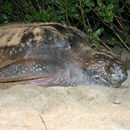en
names in breadcrumbs


Populations of leatherback turtles (Dermochelys coriacea) in the eastern Pacific have declined by more than 90% during the past two decades, primarily due to unsustainable egg harvest and fisheries bycatch mortality (Shillinger et al. 2008 and references therein). To better understand habitat use and migration patterns of these turtles, Shillinger et al. (2008) undertook a multi-year satellite tracking study and identified a very consistent migration corridor. They suggest that their data will facilitate the identification of potential areas for mitigating fisheries bycatch interactions in the eastern South Pacific.
Climate change is likely to affect Leatherback Turtles in at least three important ways (IUCN 2009):
(1) Increasing feminization:
Average global temperatures are predicted to increase by at least 2°C in the next 40 years due to climate change. This temperature increase could have serious consequences for Leatherbacks, as well as for other species whose sex is determined by embryonic temperature. The predicted outcome of this change (barring significant adaptation of the sex determination system or nesting behavior) is an increase in the number of females relative to males in Leatherback populations, which could threaten the stability of these populations. Increases in temperature have also been shown to lead to hatchling abnormalities and developmental and other health problems in young Leatherbacks (IUCN 2009).
(2) Beach erosion:
Ocean levels are thought to have risen at an average rate of 1.8 mm per year since 1961 and are predicted to rise even more rapidly in the future. Increases in storm frequency and severity have also been predicted. This is likely to lead to increased beach erosion and degradation, which could wash away turtle nests and decrease nesting habitat in the longer term. While some climate change adaptation measures, such as sea walls, help mitigate sea level rise impacts on human populations, their increased construction is likely to further reduce the availability of Leatherbacks’ nesting habitat in the future (IUCN 2009).
(3) Dispersal and food availability:
Ocean currents are important for both juvenile and adult Leatherbacks. Juveniles use them to aid dispersal following hatching and adults use them as navigational aids. Thus, changes in currents could have a major impact on Leatherback populations. Altered currents are also likely to affect the abundance and distribution of jellyfish and other Leatherback prey species. Although climate change impacts on ocean currents are likely, the nature of these changes, and hence their effects on Leatherbacks, remains uncertain (IUCN 2009).
There is some hope that Leatherbacks may be able to adapt behaviorally to the changing climate. While females are known to return to the same region--and perhaps even nesting beach--to nest each year, Leatherbacks are nevertheless among the most flexible turtle species in their nest site choice. Over time, the Leatherback's flexibility may allow them to modify their nesting site choices to select more favorable areas (in fact, northward extensions of both nesting and feeding areas have already been noted for this species). For this to be possible, however, potentially suitable beaches need to be available in more favorable areas. Coastal developments and pressures from humans have already rendered many possible sites unsuitable, and increasing sea wall development and beach erosion are likely to further reduce beach availability.
As is the case for many other vulnerable species, the ability of the Leatherback to adapt to climate change may be challenged by other threats it faces, including active harvesting by humans, accidental capture by fisheries, coastal development, and mistaken consumption by Leatherbacks of plastic debris. Such ongoing threats are likely to make the Leatherback less resilient to
additional pressures such as climate change.